Business Decision Making: Investment Analysis for DDK plc
VerifiedAdded on 2022/12/13
|10
|1603
|260
Report
AI Summary
This report examines the business decision-making process at DDK plc, a textile services and equipment provider. It analyzes two potential investment projects, Project A (Belt Project) and Project B (Trainers Project), using financial accounting techniques. The report calculates the payback period for each project, determining the time required to recover the initial investment, and computes the Net Present Value (NPV) to assess profitability considering the time value of money. The analysis reveals that Project A has a shorter payback period and a higher NPV, making it the more favorable investment. The report also discusses the impact of both financial factors (income, working capital, cash flow) and non-financial factors (marketing strategies, human skills, technology) on investment decisions. Ultimately, the report concludes that the decision-making process is crucial for managers to meet their targets and that both financial and non-financial factors should be considered for optimal investment choices.

Business Decision Making
Paraphrase This Document
Need a fresh take? Get an instant paraphrase of this document with our AI Paraphraser


Contents
INTRODUCTION...........................................................................................................................................3
MAIN BODY.................................................................................................................................................3
1. Computation of payback period:..........................................................................................................3
2. Calculation of NPV in project A and B:..............................................................................................4
3. Analysis...............................................................................................................................................5
CONCLUSION...............................................................................................................................................7
REFERENCES................................................................................................................................................8
INTRODUCTION...........................................................................................................................................3
MAIN BODY.................................................................................................................................................3
1. Computation of payback period:..........................................................................................................3
2. Calculation of NPV in project A and B:..............................................................................................4
3. Analysis...............................................................................................................................................5
CONCLUSION...............................................................................................................................................7
REFERENCES................................................................................................................................................8
⊘ This is a preview!⊘
Do you want full access?
Subscribe today to unlock all pages.

Trusted by 1+ million students worldwide
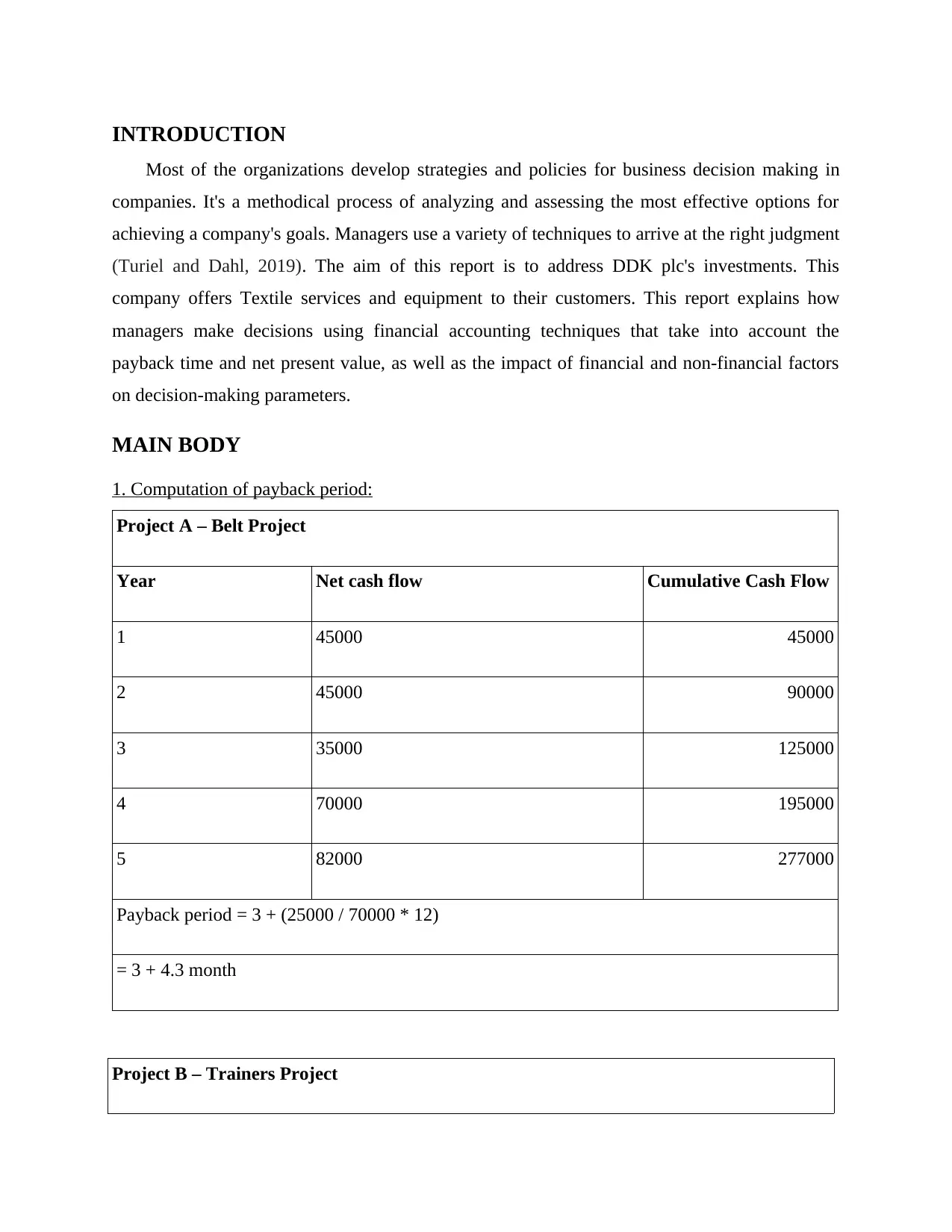
INTRODUCTION
Most of the organizations develop strategies and policies for business decision making in
companies. It's a methodical process of analyzing and assessing the most effective options for
achieving a company's goals. Managers use a variety of techniques to arrive at the right judgment
(Turiel and Dahl, 2019). The aim of this report is to address DDK plc's investments. This
company offers Textile services and equipment to their customers. This report explains how
managers make decisions using financial accounting techniques that take into account the
payback time and net present value, as well as the impact of financial and non-financial factors
on decision-making parameters.
MAIN BODY
1. Computation of payback period:
Project A – Belt Project
Year Net cash flow Cumulative Cash Flow
1 45000 45000
2 45000 90000
3 35000 125000
4 70000 195000
5 82000 277000
Payback period = 3 + (25000 / 70000 * 12)
= 3 + 4.3 month
Project B – Trainers Project
Most of the organizations develop strategies and policies for business decision making in
companies. It's a methodical process of analyzing and assessing the most effective options for
achieving a company's goals. Managers use a variety of techniques to arrive at the right judgment
(Turiel and Dahl, 2019). The aim of this report is to address DDK plc's investments. This
company offers Textile services and equipment to their customers. This report explains how
managers make decisions using financial accounting techniques that take into account the
payback time and net present value, as well as the impact of financial and non-financial factors
on decision-making parameters.
MAIN BODY
1. Computation of payback period:
Project A – Belt Project
Year Net cash flow Cumulative Cash Flow
1 45000 45000
2 45000 90000
3 35000 125000
4 70000 195000
5 82000 277000
Payback period = 3 + (25000 / 70000 * 12)
= 3 + 4.3 month
Project B – Trainers Project
Paraphrase This Document
Need a fresh take? Get an instant paraphrase of this document with our AI Paraphraser
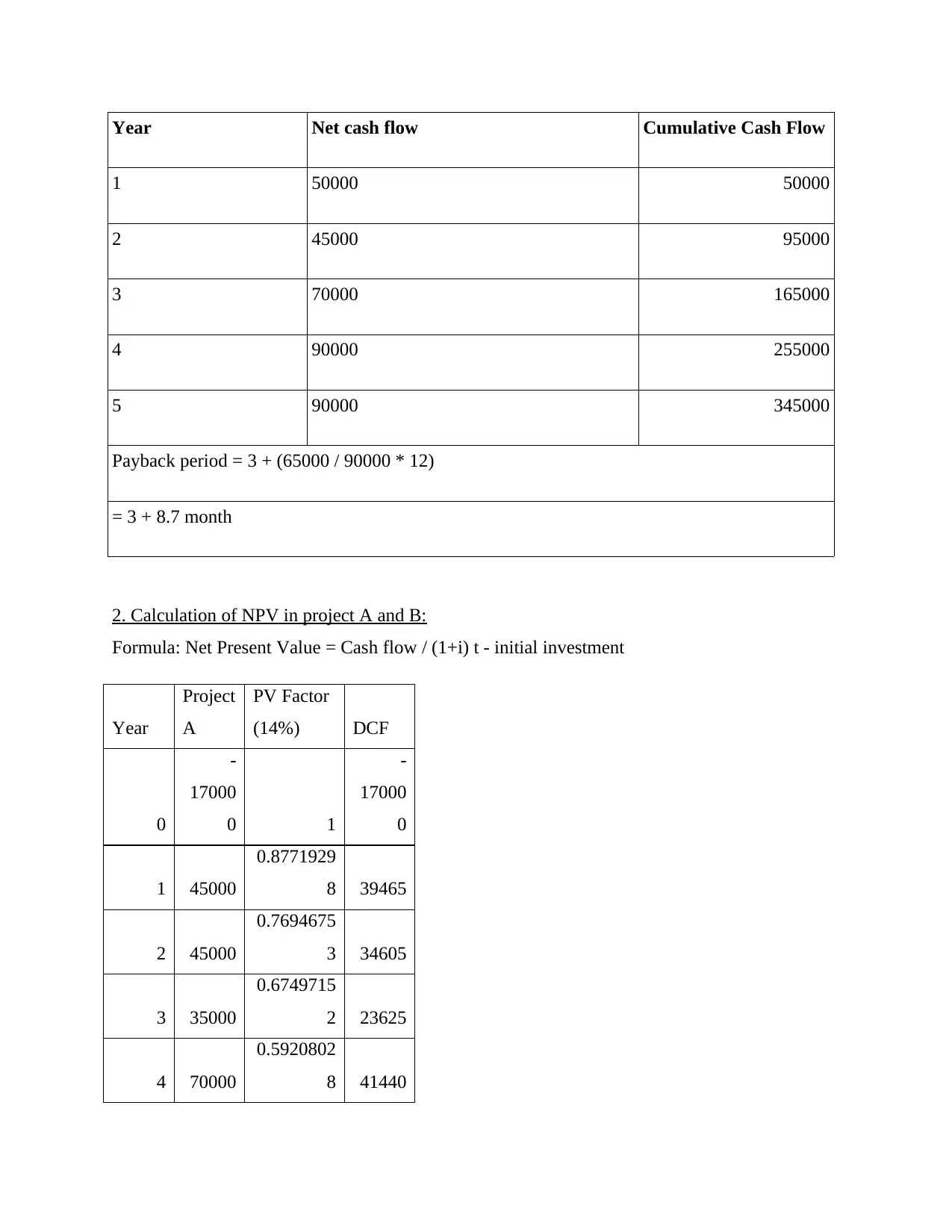
Year Net cash flow Cumulative Cash Flow
1 50000 50000
2 45000 95000
3 70000 165000
4 90000 255000
5 90000 345000
Payback period = 3 + (65000 / 90000 * 12)
= 3 + 8.7 month
2. Calculation of NPV in project A and B:
Formula: Net Present Value = Cash flow / (1+i) t - initial investment
Year
Project
A
PV Factor
(14%) DCF
0
-
17000
0 1
-
17000
0
1 45000
0.8771929
8 39465
2 45000
0.7694675
3 34605
3 35000
0.6749715
2 23625
4 70000
0.5920802
8 41440
1 50000 50000
2 45000 95000
3 70000 165000
4 90000 255000
5 90000 345000
Payback period = 3 + (65000 / 90000 * 12)
= 3 + 8.7 month
2. Calculation of NPV in project A and B:
Formula: Net Present Value = Cash flow / (1+i) t - initial investment
Year
Project
A
PV Factor
(14%) DCF
0
-
17000
0 1
-
17000
0
1 45000
0.8771929
8 39465
2 45000
0.7694675
3 34605
3 35000
0.6749715
2 23625
4 70000
0.5920802
8 41440
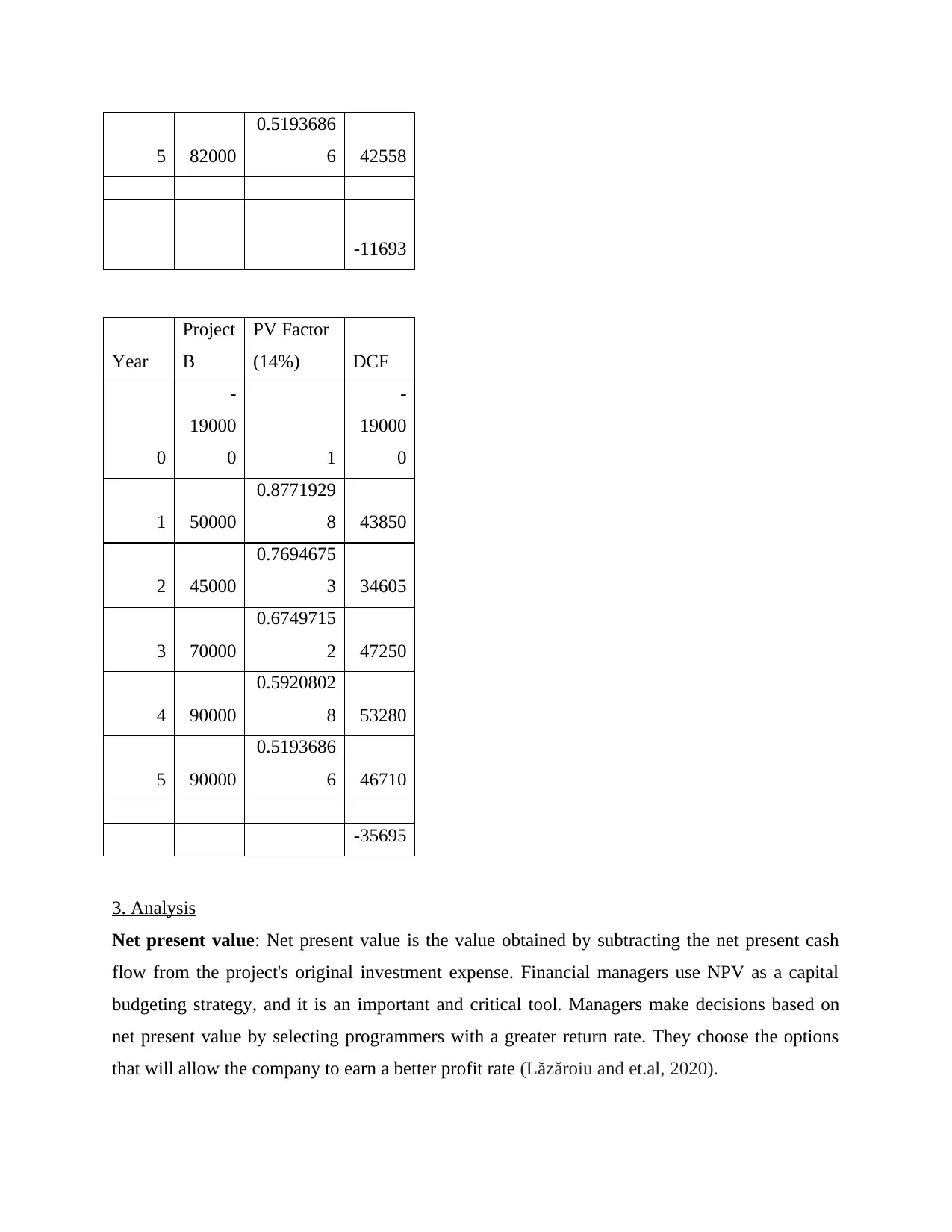
5 82000
0.5193686
6 42558
-11693
Year
Project
B
PV Factor
(14%) DCF
0
-
19000
0 1
-
19000
0
1 50000
0.8771929
8 43850
2 45000
0.7694675
3 34605
3 70000
0.6749715
2 47250
4 90000
0.5920802
8 53280
5 90000
0.5193686
6 46710
-35695
3. Analysis
Net present value: Net present value is the value obtained by subtracting the net present cash
flow from the project's original investment expense. Financial managers use NPV as a capital
budgeting strategy, and it is an important and critical tool. Managers make decisions based on
net present value by selecting programmers with a greater return rate. They choose the options
that will allow the company to earn a better profit rate (Lăzăroiu and et.al, 2020).
0.5193686
6 42558
-11693
Year
Project
B
PV Factor
(14%) DCF
0
-
19000
0 1
-
19000
0
1 50000
0.8771929
8 43850
2 45000
0.7694675
3 34605
3 70000
0.6749715
2 47250
4 90000
0.5920802
8 53280
5 90000
0.5193686
6 46710
-35695
3. Analysis
Net present value: Net present value is the value obtained by subtracting the net present cash
flow from the project's original investment expense. Financial managers use NPV as a capital
budgeting strategy, and it is an important and critical tool. Managers make decisions based on
net present value by selecting programmers with a greater return rate. They choose the options
that will allow the company to earn a better profit rate (Lăzăroiu and et.al, 2020).
⊘ This is a preview!⊘
Do you want full access?
Subscribe today to unlock all pages.

Trusted by 1+ million students worldwide
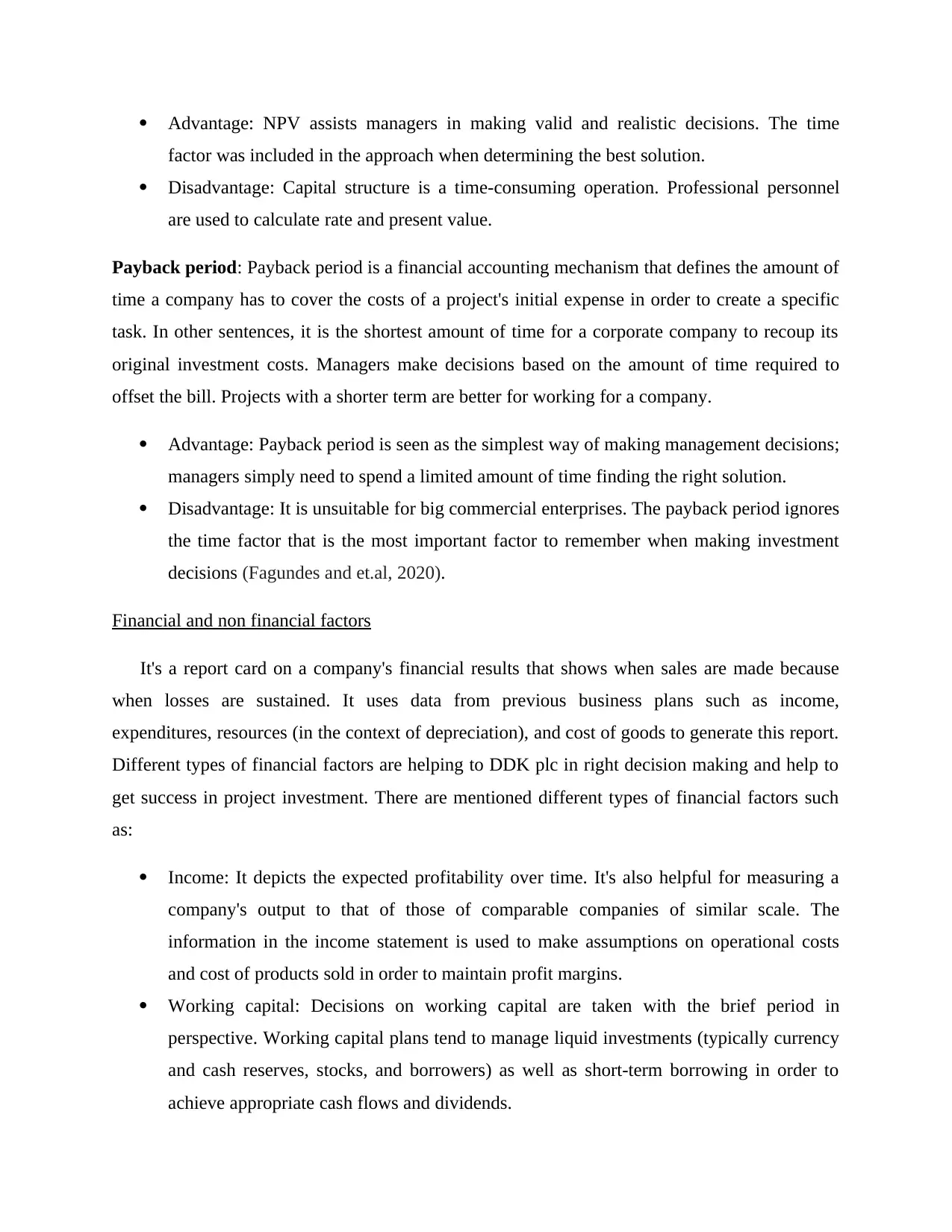
Advantage: NPV assists managers in making valid and realistic decisions. The time
factor was included in the approach when determining the best solution.
Disadvantage: Capital structure is a time-consuming operation. Professional personnel
are used to calculate rate and present value.
Payback period: Payback period is a financial accounting mechanism that defines the amount of
time a company has to cover the costs of a project's initial expense in order to create a specific
task. In other sentences, it is the shortest amount of time for a corporate company to recoup its
original investment costs. Managers make decisions based on the amount of time required to
offset the bill. Projects with a shorter term are better for working for a company.
Advantage: Payback period is seen as the simplest way of making management decisions;
managers simply need to spend a limited amount of time finding the right solution.
Disadvantage: It is unsuitable for big commercial enterprises. The payback period ignores
the time factor that is the most important factor to remember when making investment
decisions (Fagundes and et.al, 2020).
Financial and non financial factors
It's a report card on a company's financial results that shows when sales are made because
when losses are sustained. It uses data from previous business plans such as income,
expenditures, resources (in the context of depreciation), and cost of goods to generate this report.
Different types of financial factors are helping to DDK plc in right decision making and help to
get success in project investment. There are mentioned different types of financial factors such
as:
Income: It depicts the expected profitability over time. It's also helpful for measuring a
company's output to that of those of comparable companies of similar scale. The
information in the income statement is used to make assumptions on operational costs
and cost of products sold in order to maintain profit margins.
Working capital: Decisions on working capital are taken with the brief period in
perspective. Working capital plans tend to manage liquid investments (typically currency
and cash reserves, stocks, and borrowers) as well as short-term borrowing in order to
achieve appropriate cash flows and dividends.
factor was included in the approach when determining the best solution.
Disadvantage: Capital structure is a time-consuming operation. Professional personnel
are used to calculate rate and present value.
Payback period: Payback period is a financial accounting mechanism that defines the amount of
time a company has to cover the costs of a project's initial expense in order to create a specific
task. In other sentences, it is the shortest amount of time for a corporate company to recoup its
original investment costs. Managers make decisions based on the amount of time required to
offset the bill. Projects with a shorter term are better for working for a company.
Advantage: Payback period is seen as the simplest way of making management decisions;
managers simply need to spend a limited amount of time finding the right solution.
Disadvantage: It is unsuitable for big commercial enterprises. The payback period ignores
the time factor that is the most important factor to remember when making investment
decisions (Fagundes and et.al, 2020).
Financial and non financial factors
It's a report card on a company's financial results that shows when sales are made because
when losses are sustained. It uses data from previous business plans such as income,
expenditures, resources (in the context of depreciation), and cost of goods to generate this report.
Different types of financial factors are helping to DDK plc in right decision making and help to
get success in project investment. There are mentioned different types of financial factors such
as:
Income: It depicts the expected profitability over time. It's also helpful for measuring a
company's output to that of those of comparable companies of similar scale. The
information in the income statement is used to make assumptions on operational costs
and cost of products sold in order to maintain profit margins.
Working capital: Decisions on working capital are taken with the brief period in
perspective. Working capital plans tend to manage liquid investments (typically currency
and cash reserves, stocks, and borrowers) as well as short-term borrowing in order to
achieve appropriate cash flows and dividends.
Paraphrase This Document
Need a fresh take? Get an instant paraphrase of this document with our AI Paraphraser
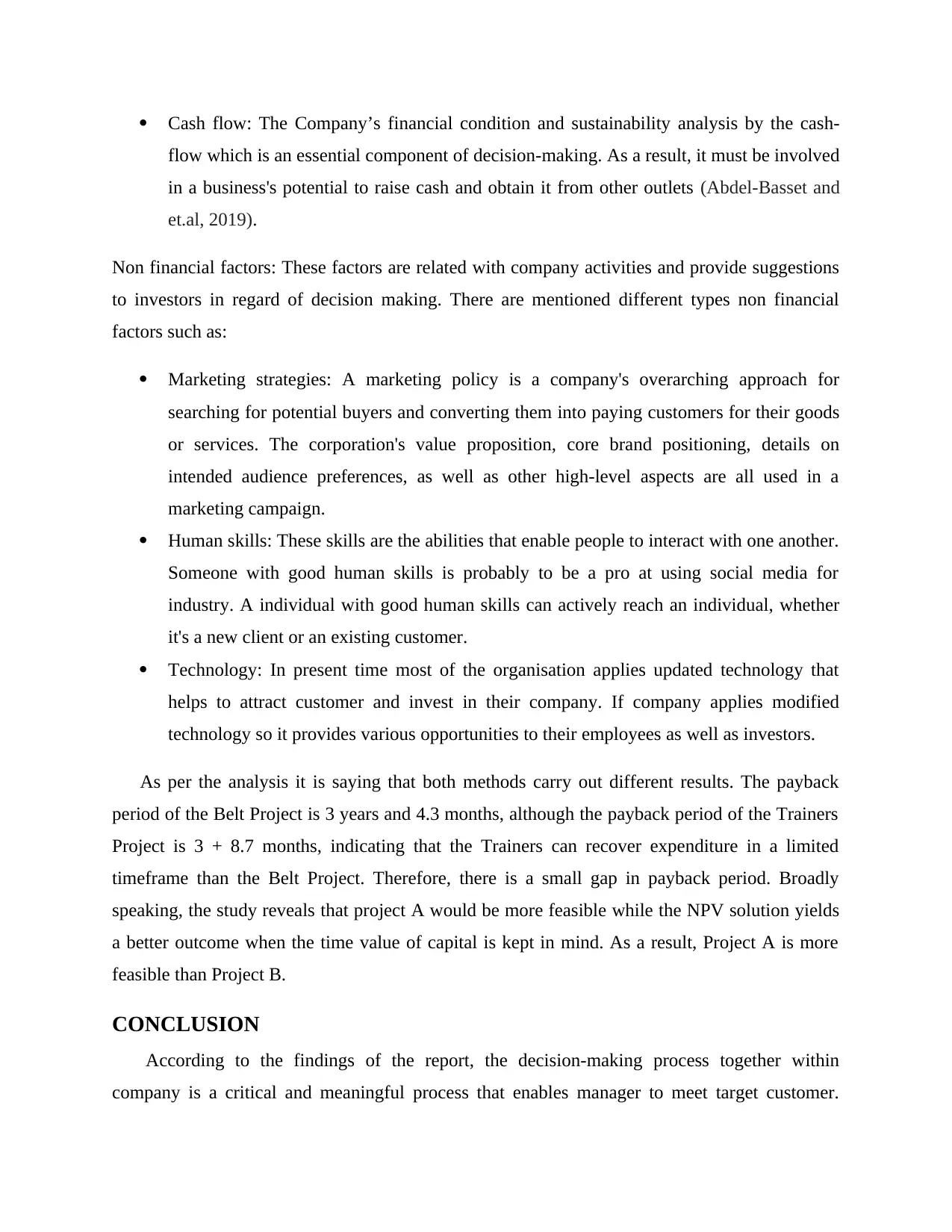
Cash flow: The Company’s financial condition and sustainability analysis by the cash-
flow which is an essential component of decision-making. As a result, it must be involved
in a business's potential to raise cash and obtain it from other outlets (Abdel-Basset and
et.al, 2019).
Non financial factors: These factors are related with company activities and provide suggestions
to investors in regard of decision making. There are mentioned different types non financial
factors such as:
Marketing strategies: A marketing policy is a company's overarching approach for
searching for potential buyers and converting them into paying customers for their goods
or services. The corporation's value proposition, core brand positioning, details on
intended audience preferences, as well as other high-level aspects are all used in a
marketing campaign.
Human skills: These skills are the abilities that enable people to interact with one another.
Someone with good human skills is probably to be a pro at using social media for
industry. A individual with good human skills can actively reach an individual, whether
it's a new client or an existing customer.
Technology: In present time most of the organisation applies updated technology that
helps to attract customer and invest in their company. If company applies modified
technology so it provides various opportunities to their employees as well as investors.
As per the analysis it is saying that both methods carry out different results. The payback
period of the Belt Project is 3 years and 4.3 months, although the payback period of the Trainers
Project is 3 + 8.7 months, indicating that the Trainers can recover expenditure in a limited
timeframe than the Belt Project. Therefore, there is a small gap in payback period. Broadly
speaking, the study reveals that project A would be more feasible while the NPV solution yields
a better outcome when the time value of capital is kept in mind. As a result, Project A is more
feasible than Project B.
CONCLUSION
According to the findings of the report, the decision-making process together within
company is a critical and meaningful process that enables manager to meet target customer.
flow which is an essential component of decision-making. As a result, it must be involved
in a business's potential to raise cash and obtain it from other outlets (Abdel-Basset and
et.al, 2019).
Non financial factors: These factors are related with company activities and provide suggestions
to investors in regard of decision making. There are mentioned different types non financial
factors such as:
Marketing strategies: A marketing policy is a company's overarching approach for
searching for potential buyers and converting them into paying customers for their goods
or services. The corporation's value proposition, core brand positioning, details on
intended audience preferences, as well as other high-level aspects are all used in a
marketing campaign.
Human skills: These skills are the abilities that enable people to interact with one another.
Someone with good human skills is probably to be a pro at using social media for
industry. A individual with good human skills can actively reach an individual, whether
it's a new client or an existing customer.
Technology: In present time most of the organisation applies updated technology that
helps to attract customer and invest in their company. If company applies modified
technology so it provides various opportunities to their employees as well as investors.
As per the analysis it is saying that both methods carry out different results. The payback
period of the Belt Project is 3 years and 4.3 months, although the payback period of the Trainers
Project is 3 + 8.7 months, indicating that the Trainers can recover expenditure in a limited
timeframe than the Belt Project. Therefore, there is a small gap in payback period. Broadly
speaking, the study reveals that project A would be more feasible while the NPV solution yields
a better outcome when the time value of capital is kept in mind. As a result, Project A is more
feasible than Project B.
CONCLUSION
According to the findings of the report, the decision-making process together within
company is a critical and meaningful process that enables manager to meet target customer.

Managers analyze every step in this phase in order to make a final decision. Consequently, as
previously mentioned, there are a number of options that can help and guide decision making.
previously mentioned, there are a number of options that can help and guide decision making.
⊘ This is a preview!⊘
Do you want full access?
Subscribe today to unlock all pages.

Trusted by 1+ million students worldwide
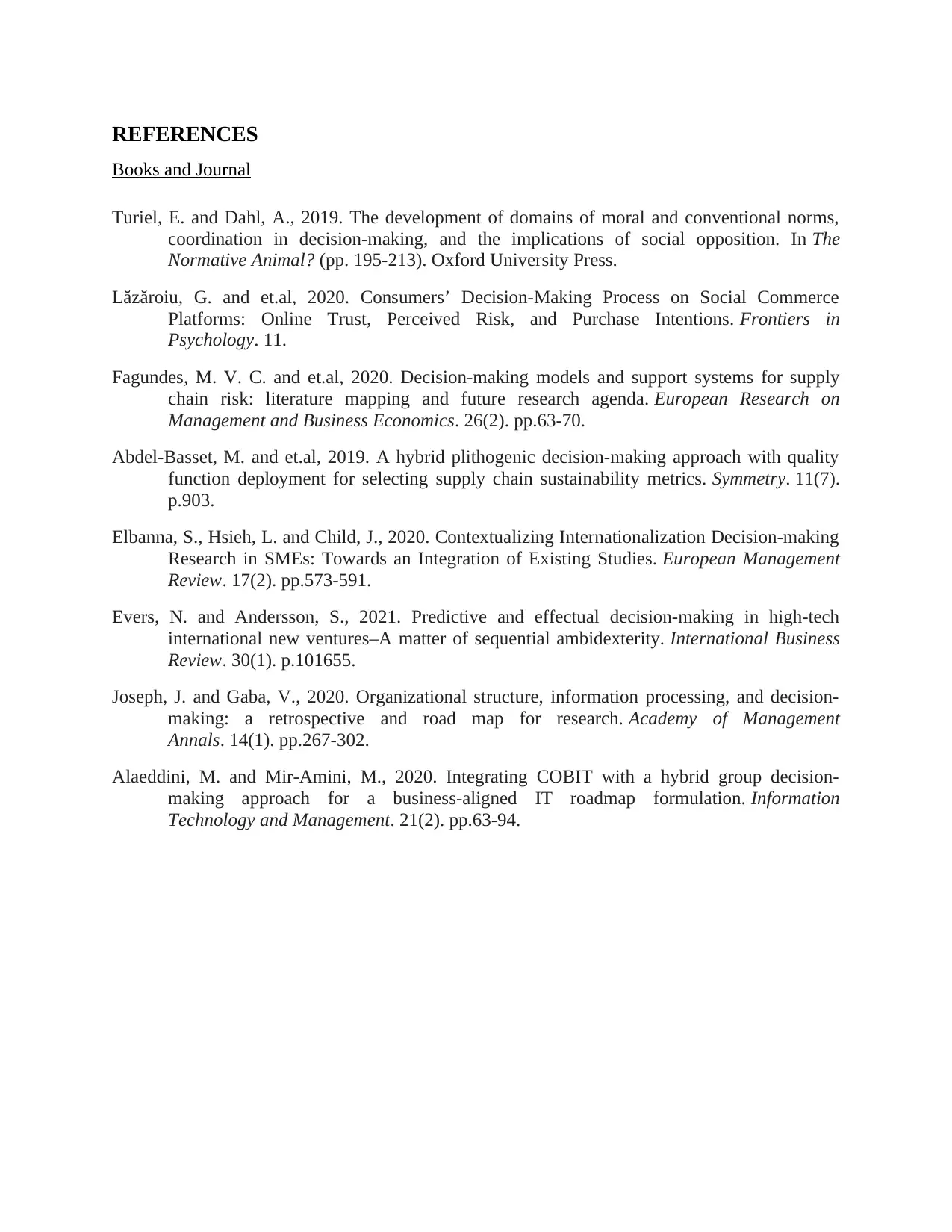
REFERENCES
Books and Journal
Turiel, E. and Dahl, A., 2019. The development of domains of moral and conventional norms,
coordination in decision-making, and the implications of social opposition. In The
Normative Animal? (pp. 195-213). Oxford University Press.
Lăzăroiu, G. and et.al, 2020. Consumers’ Decision-Making Process on Social Commerce
Platforms: Online Trust, Perceived Risk, and Purchase Intentions. Frontiers in
Psychology. 11.
Fagundes, M. V. C. and et.al, 2020. Decision-making models and support systems for supply
chain risk: literature mapping and future research agenda. European Research on
Management and Business Economics. 26(2). pp.63-70.
Abdel-Basset, M. and et.al, 2019. A hybrid plithogenic decision-making approach with quality
function deployment for selecting supply chain sustainability metrics. Symmetry. 11(7).
p.903.
Elbanna, S., Hsieh, L. and Child, J., 2020. Contextualizing Internationalization Decision‐making
Research in SMEs: Towards an Integration of Existing Studies. European Management
Review. 17(2). pp.573-591.
Evers, N. and Andersson, S., 2021. Predictive and effectual decision-making in high-tech
international new ventures–A matter of sequential ambidexterity. International Business
Review. 30(1). p.101655.
Joseph, J. and Gaba, V., 2020. Organizational structure, information processing, and decision-
making: a retrospective and road map for research. Academy of Management
Annals. 14(1). pp.267-302.
Alaeddini, M. and Mir-Amini, M., 2020. Integrating COBIT with a hybrid group decision-
making approach for a business-aligned IT roadmap formulation. Information
Technology and Management. 21(2). pp.63-94.
Books and Journal
Turiel, E. and Dahl, A., 2019. The development of domains of moral and conventional norms,
coordination in decision-making, and the implications of social opposition. In The
Normative Animal? (pp. 195-213). Oxford University Press.
Lăzăroiu, G. and et.al, 2020. Consumers’ Decision-Making Process on Social Commerce
Platforms: Online Trust, Perceived Risk, and Purchase Intentions. Frontiers in
Psychology. 11.
Fagundes, M. V. C. and et.al, 2020. Decision-making models and support systems for supply
chain risk: literature mapping and future research agenda. European Research on
Management and Business Economics. 26(2). pp.63-70.
Abdel-Basset, M. and et.al, 2019. A hybrid plithogenic decision-making approach with quality
function deployment for selecting supply chain sustainability metrics. Symmetry. 11(7).
p.903.
Elbanna, S., Hsieh, L. and Child, J., 2020. Contextualizing Internationalization Decision‐making
Research in SMEs: Towards an Integration of Existing Studies. European Management
Review. 17(2). pp.573-591.
Evers, N. and Andersson, S., 2021. Predictive and effectual decision-making in high-tech
international new ventures–A matter of sequential ambidexterity. International Business
Review. 30(1). p.101655.
Joseph, J. and Gaba, V., 2020. Organizational structure, information processing, and decision-
making: a retrospective and road map for research. Academy of Management
Annals. 14(1). pp.267-302.
Alaeddini, M. and Mir-Amini, M., 2020. Integrating COBIT with a hybrid group decision-
making approach for a business-aligned IT roadmap formulation. Information
Technology and Management. 21(2). pp.63-94.
1 out of 10
Related Documents
Your All-in-One AI-Powered Toolkit for Academic Success.
+13062052269
info@desklib.com
Available 24*7 on WhatsApp / Email
![[object Object]](/_next/static/media/star-bottom.7253800d.svg)
Unlock your academic potential
Copyright © 2020–2025 A2Z Services. All Rights Reserved. Developed and managed by ZUCOL.





